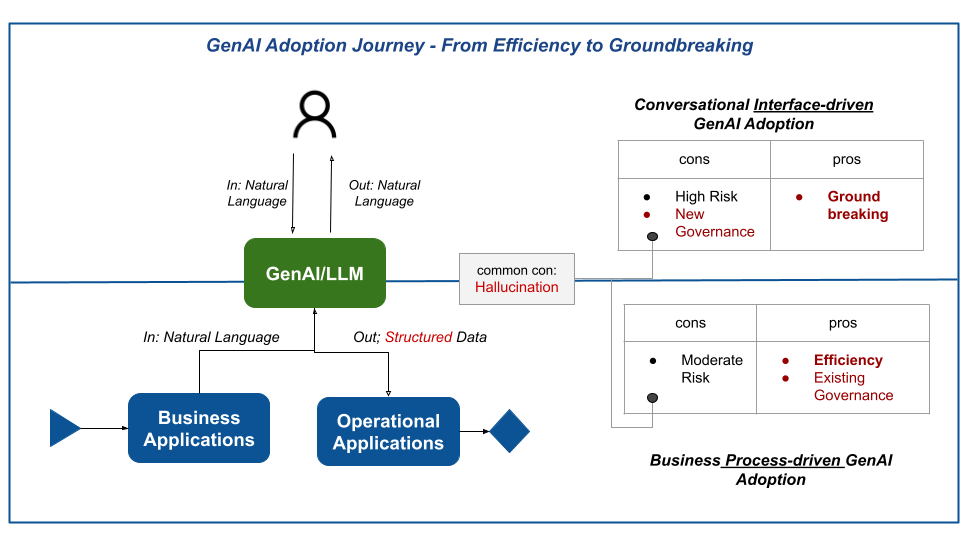A General Guideline for Enterprise GenAI Initiative
Natural Language Comprehension: The Key to Powerful AI Generation
The late 2022 release of OpenAI’s ChatGPT marked a significant milestone in AI development. Its ability to generate human-quality text, code, and even creative formats like images and videos fueled excitement about GenAI’s potential. However, unlocking this potential hinges on GenAI’s ability to comprehend human language nuances, particularly context.
Prior to 2017, machines could process individual words and sentences, but understanding language within its specific context remained a challenge. Humans intuitively grasp that meaning in language is highly contextual. A breakthrough occurred in 2017 when Google researchers introduced a novel machine learning algorithm called the Transformer, based on the concept of attention. Unlike previous methods, Transformers allow machines to analyze words in relation to their surrounding context. This innovation fundamentally transformed how machines process language, enabling them to grasp meaning within context for the first time. This newfound understanding significantly bolstered GenAI’s ability to generate novel and coherent language.
GenAI Adoption Use Cases
The Rise of Generative AI and its Potential to Transform Business Processes
While a significant portion of data in enterprise business processes is structured, the volume of unstructured language text is equally substantial. However, human interaction has traditionally been a necessity due to the challenge of machine comprehension of free-form text. This limitation often necessitates incorporating human intervention into various business processes.
Generative AI, particularly Transformer-based models, offers a breakthrough in language comprehension. By integrating GenAI into business processes, we can potentially automate them end-to-end, leading to significant improvements in business and operational efficiency.
Human-to-Machine Interaction: A New Paradigm
Previously, humans solely generated language text. The new capabilities of AI in both comprehension and generation open the door for direct human-machine interaction. Many customer-to-employee and employee-to-employee conversations could be streamlined through human-to-machine interaction.
GenAI Adoption: A Two-Pronged Approach
Broadly, GenAI adoption use cases can be categorized into two main groups:
-
Conversational Interface-Driven: This category focuses on user-facing applications. Imagine chatbots capable of nuanced customer conversations, AI assistants personalizing marketing campaigns in real-time, or design tools generating concepts based on user descriptions. NLI-driven applications hold immense potential to transform customer experiences, create new revenue streams, and significantly enhance employee productivity.
-
Business Process-Driven: This category focuses on streamlining internal operations through automation. NLP-driven applications can automate data entry, report generation based on natural language queries, or even summarize complex documents for faster review. These applications improve operational efficiency by freeing up valuable human resources for more strategic tasks.
Risk and Reward: Balancing Innovation with Control in GenAI Adoption
Conversational interface-driven applications, while brimming with transformative potential, present unique challenges. Natural Language Interfaces (NLIs) operate in an unstructured format, demanding novel approaches to manage both human input and machine output. Furthermore, they introduce a wider range of external actors into business environments, potentially increasing risk. Developing and implementing such complex solutions can be expensive and time-consuming, with the inherent possibility of encountering unforeseen difficulties.
Process-driven use cases, conversely, offer a more measured approach. These applications leverage GenAI to process existing language data within controlled business environments. Replacing human interaction with GenAI processing can actually enhance control over the workflow. As a result, process-driven use cases present a quicker path to success by automating existing workflows and delivering tangible results in the short term.
Building a Strong Foundation: Starting with Process Automation
In light of the rapid advancements in Generative AI (GenAI), we recommend prioritizing business process-driven use cases for several compelling reasons:
- Develop GenAI Expertise: By tackling concrete process automation tasks, your team gains valuable hands-on experience working with GenAI tools and best practices. This establishes a strong foundation for future, more ambitious GenAI initiatives.
- Secure Early Wins: Demonstrating the effectiveness of GenAI through successful process automation projects fosters confidence and buy-in within the organization, paving the way for wider adoption.
- Prepare for the Future: As your team builds GenAI expertise and the technology matures, you can strategically transition into more complex conversational interface-driven applications. Identifying GenAI Adoption Use Cases
lastly, we present the following diagram to illustrate the the whole process of identifying ideal GenAI adoption use cases
